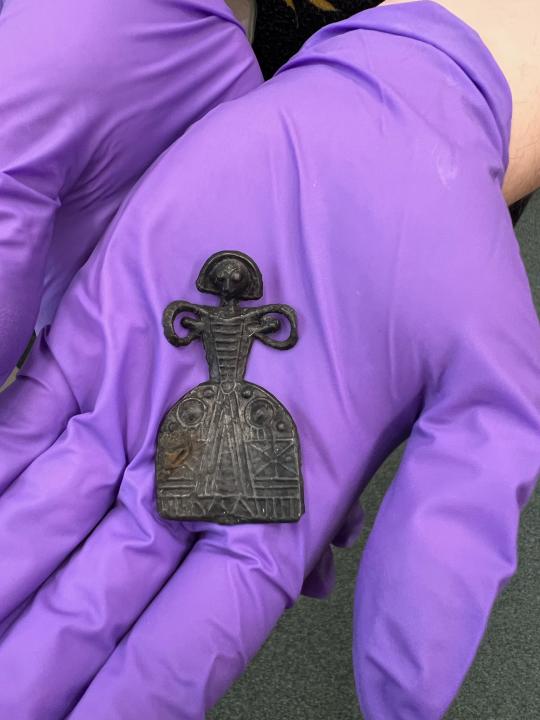Mudlarker finds ‘very rare’ post-Medieval lead doll in brook near home
An avid mudlarker has shared her excitement after discovering a “very rare” lead doll in a brook near her home which experts believe is the only complete find recorded in the country.
Sarah Brackstone happened upon the “special” item, which is thought to be a post-Medieval lead doll, in February while out with her metal detector – a Minelab Equinox 800.
“I was out in the brook and my pinpointer was going off and I could not see anything because the water was all murky,” the 47-year-old who lives in the East Midlands told the PA news agency.

“It must have taken me nearly 20 minutes and I was wrenching her out and didn’t even know what it was.
“When I pulled her out and she was complete, I thought, ‘Oh my God, no way’.”
Ms Brackstone has found the torso of a similar doll in the past, but finding one complete is “very rare”, according to Michael Lewis, who is head of the Portable Antiquities Scheme (PAS), which records archaeological finds discovered by the public and is run in England by the British Museum.
“It is a fantastic survival,” Professor Lewis told PA.
“It’s quite interesting it survives because it’s made from lead, a metal that is quite likely to be broken.
“(It is) probably important to say that the survival of lead objects is more common in watery contexts.
“When these break, the breakage points are unsurprisingly at the head and waist, so we have seen some of these without the head or the dress, so having one that’s completely complete is obviously very rare.”

He said there are around 20 parts of dolls of a similar type recorded on the PAS database, with only this example complete.
Talking through some of the details on the doll, Prof Lewis said: “On this one, the lady seems to be wearing a bodice and then a great big flaring dress.
“Intriguingly, the dress is decorated with some really interesting geometric designs which might help link dolls found in different places.
“At the back of (the doll), you can see what looks like a necklace which you don’t see on the front. The doll has some generic features like a triangular nose and bulging eyes.”
He added that while it is hard to know for certain how the dolls were used in the post-Medieval period, the loops near the figure’s arms suggest it could have been used as a puppet by placing string inside them so parents could entertain their children.
Ms Brackstone said she emailed Megan Gard, the finds liaison officer (FLO) for Leicestershire and Rutland, who is based at Rutland County Museum and created the record for the doll.
Ms Gard said the doll “caused such a ruckus” amongst staff at the museum as there are just a “handful” of parts of dolls of a similar kind recorded on the PAS database.
“I’ve recorded bodices before but not an entire doll,” she told PA.
Ms Brackstone has mudlarked regularly for five years and said she has “always picked up bits and bobs”. She has found hundreds of items including skulls, teeth, a Tudor spoon and a 500-year-old beehive thimble but nothing as “amazing” as the doll.
She added: “To be the person that found that is quite special because it’s like the holy grail of dolls.”
She plans to loan the doll to the British Museum and there has also been international interest, with some collectors in America enquiring about purchasing it and over 11,000 people interacting with her post about the find.

She added: “It’s nice to save history because with the amount of development going on, you just don’t know whether all these things are going to be scooped up in a pile and removed and it’s all a part of our social history and I think it’s very important for the country.
“You see all these other people finding amazing things and never expect to find one yourself and then something like this comes along and it’s almost like you’ve reached the pinnacle.”
Prof Lewis said people can search for archaeological finds with the landowners’ permission and should avoid protected sites, which includes scheduled monuments.
He added: “If a find is Treasure (generally gold or silver items or hoards of coins), then [people] have a legal obligation to report it, otherwise they can record it on a voluntary basis with the Portable Antiquities Scheme (PAS) – as in this case.
“Legally, the find belongs to the landowner, but many landowners let finders keep what they find (they should have an agreement on that).”


